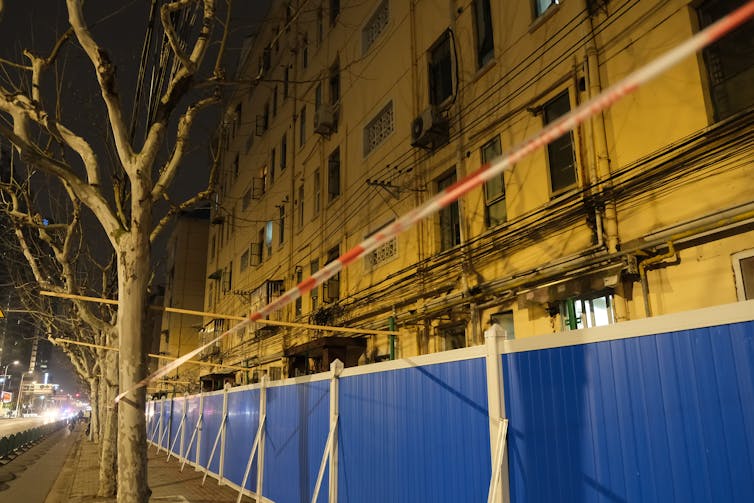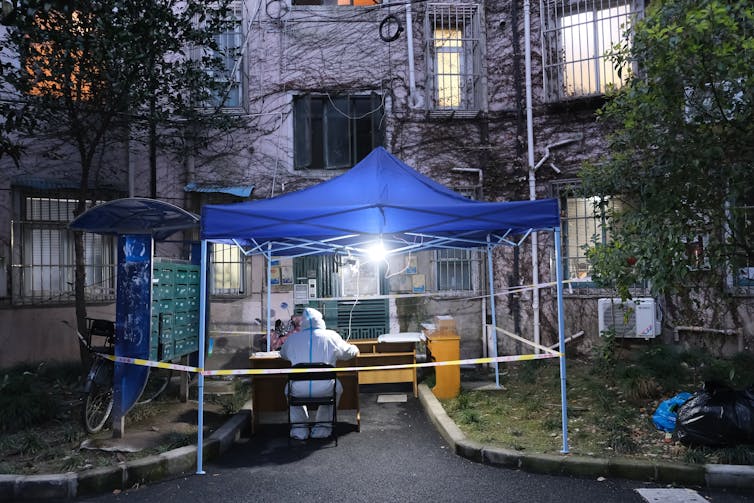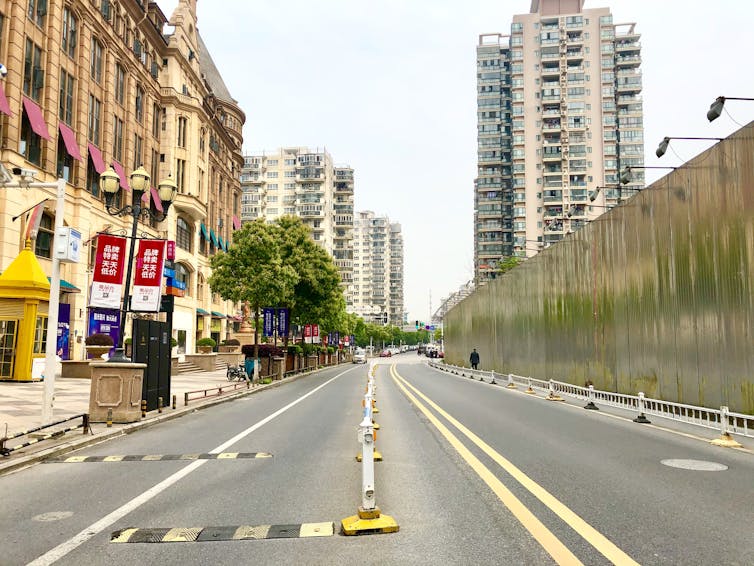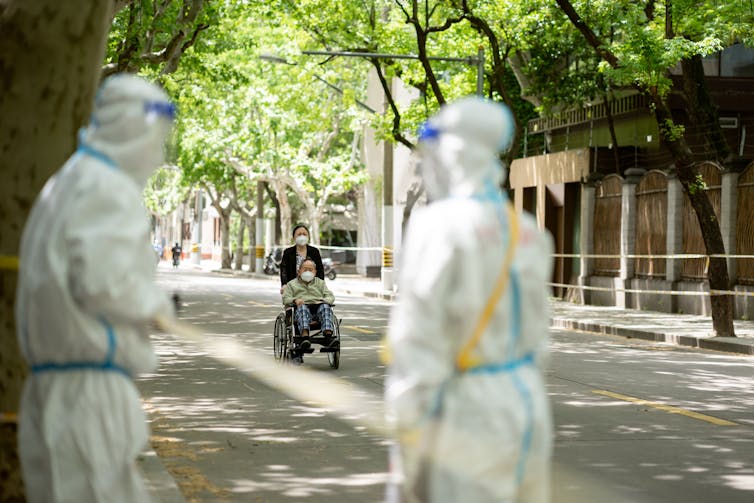By Jane Duckett, Meixuan Chen & William Wang*
More than two years after a deadly strain of coronavirus was first identified in the central city of Wuhan, China remains locked in a COVID crisis. Around 400 million people are currently thought to be living under some form of lockdown across the country. One of China’s largest cities, Shanghai, has been paralysed for the past month, with many of its residents hemmed in by hastily erected metal fences. The capital, Beijing, is now striving to avoid a similar fate.
The extraordinary story of China’s ongoing, and increasingly desperate, struggle against COVID-19 combines hubris at its own early public health successes with a failure to sufficiently vaccinate its elderly people, and is fuelled by rising anti-Western sentiment over the last five years. The result is that China now faces a dilemma: either the high numbers of deaths and overwhelmed health services that would result from a rampant virus, or the rapidly mounting social and economic costs of prolonged lockdowns and stay-at-home orders nationwide.
But resolving China’s COVID dilemma and finding a route out of the pandemic is complicated by the difficulties of challenging a “zero-COVID” strategy so closely associated with China’s top leader, Xi Jinping. Xi is due to be re-appointed for a controversial third term as General Secretary of the Chinese Communist Party at its five-yearly Congress in the autumn. He will not want a rampant virus and high death rates to tarnish his reputation and undermine his, and the Party’s, claims that they have handled the pandemic better than other countries.
How did China get to this point? And what can it do to resolve a crisis that threatens not just the health and security of its people, but of the world’s largest economy – and those of the many countries that rely on its vast supply chains. At the University of Glasgow’s Scottish Centre for China Research, we have been tracking the rollercoaster evolution of the Chinese government’s COVID strategy, and the impacts of its containment measures, since news of the virus first reached us in early 2020. Combining on-the-ground reports from researchers with reviews of policy documents and social media outpourings, this is our analysis of China’s COVID crisis – present, past and future.
Groundhog day
“Every day I wake up to find it is the first day of the 14-day cycle.” This is the title of a Wechat blogpost (now deleted) by Wei Zhou, a well-known reporter, columnist and long-term resident of Shanghai. The city he shares with more than 26 million people has been under a strict COVID lockdown for more than a month now. Wei Zhou’s title refers to the regulation that states a residential compound’s 14-day lockdown period must reset to zero every time someone new tests positive. As a result, residents find themselves in a world of Kafka-esque absurdity, potentially subject to the ire of their neighbours if they test positive, unsure about what happens next.
But just as Shanghai residents may now regard every day as Groundhog Day, the Communist Party leadership might also be wondering how China can escape this pandemic – and the dilemma it has created. More than two years after the first COVID lockdown in Wuhan, China is again struggling to contain the spread of the latest variant, omicron.
In a desperate attempt to avoid the socioeconomic chaos and political damage seen in Shanghai, China’s capital Beijing began eight rounds of mass testing in early May following an outbreak of cases. It has re-opened a mass isolation centre, forbidden dining in all restaurants, and closed kindergartens, schools and colleges until at least May 11. The situation is fast-changing: all 6.6 million residents of Chaoyang and Haidian districts have just been told to follow stay-at-home orders, three metro lines have been suspended and six others partially closed.
Meanwhile in Shanghai, whose streets remain hauntingly empty despite falling infection rates, the future is unclear. Since cases began to appear in early March, residents have experienced a series of measures that demonstrate the authorities’ still-evolving approach to dealing with outbreaks. After first sealing off Shanghai, cutting transport links in and out, they rolled out mass testing across the entire population, dividing the city into two halves and preventing movement in between. They then introduced three-zone prevention and control measures that divided the city into “sealed control zones” subject to stay-at-home orders, “managed control zones” allowing people limited local mobility, and “precautionary zones” with (supposedly) fewer restrictions.
In theory, this approach would avoid a city-wide lockdown through highly localised measures. In practice, it has done the opposite because the rules have been implemented so strictly. Despite infection rates falling steadily since mid-April, even residents in precautionary zones still need a permit to leave their immediate area and go on to the streets. Private cars require a permit to move around the city. University students in Shanghai have been notified their classes will continue online until at least the end of June.
At the same time as doubling down on their efforts to contain omicron, the Chinese authorities have done their best to downplay them. Local governments sometimes employ euphemistic terms while asserting they are not deploying city-wide lockdowns. The three-zone policy is an example, but while it creates confusion for residents – such that Tencent and other online companies now provide real-time maps of restrictions in different neighbourhoods and cities – it also offers some hope of a route to fewer restrictions. In so doing, it may switch residents’ attention from criticising the government to caring about case numbers in their neighbourhoods.

And while Shanghai’s lockdown has made the news internationally, it is far from the only place to be experiencing severe restrictions. Reliable national figures on the extent of travel restrictions and stay-at-home orders are difficult to acquire, but it has been estimated that between 45 and 87 of China’s cities, from the north-east to the south-west, may now have some form of stay-at-home order in place. Even before Beijing and Zhengzhou, capital of Henan province, went into lockdown on May 4, estimates suggested as many as 375 million people were affected.
The countryside is being hit too, even in less densely populated rural areas. Farmers in some parts of the north-east require “spring sowing certificates” to be able to work their fields. At least one farmer has been detained for breaking COVID restrictions while simply working alone in his field.
Rising social and economic costs
For some Chinese citizens, the social costs of the authorities’ stringent measures have been extremely serious – and in some cases, fatal. With stay-at-home orders heavy-handedly enforced by officials under pressure to prevent the virus spreading, we have seen numerous reports on social media of delivery drivers being confined in residential compounds, shoppers returning home to find they are unable to get back into their apartments, and children as young as two being separated from their parents and forced to quarantine in isolation centres. With highways and service areas around Shanghai closed at short notice, many drivers have been trapped inside their trucks, including one who spent two weeks on the road between Chongqing and Shanghai – a drive that should have taken two days.
In some parts of Shanghai, residents have suffered food shortages. Others have been unable to seek hospital treatment because they cannot get the permits they now need for treatment of even chronic and terminal illnesses. A 98-year-old woman died while waiting for a COVID test result before she could get medical treatment for chronic renal failure, and an elderly man died because he could not get his regular dialysis treatment. A retired infectious disease expert, Dr Miu Xiaohui, estimated in a subsequently-censored blogpost that the excess mortality from diabetes alone during Shanghai’s one-month lockdown had been 2,141 people.
Suicides, mental health issues and other social problems have been reported on Chinese social media. In Shanghai, a female journalist apparently fell from a building on May 5 after her anti-depressants ran out and a district health official reportedly took his own life while at work on April 13 due to the stress of his COVID enforcement duties. Meanwhile, across China’s locked-down cities, we have seen reports that domestic violence is on the rise. The charity Orange Umbrella, which campaigns against gender violence, published three posts on May 5 under the heading: “A Guide for Seeking Help in Lockdown”.
And then there are the economic costs. In Shanghai, suspended manufacturing activities can only restart if businesses commit to “closed loop management” – a system used during the recent Winter Olympics in Beijing that creates a self-contained environment so the virus cannot be brought in. Employees are required to remain on site at all times – difficult for employers with no dormitory facilities. Production problems, compounded by difficulties transporting goods due to travel restrictions, are currently disrupting supply chains in the Shanghai area, with knock-on effects for global supply chains.
Within China, consumer demand is down, negatively affecting financial markets, and China’s currency, the Renminbi, has been weakened. The International Monetary Fund has revised down its economic growth forecast for China in 2022 from 5.5% last October to 4.4% in April, with some investment banks even less optimistic.
There are more than 70,000 foreign-invested companies in Shanghai alone. According to a survey by the EU Chamber of Commerce in China, 65% of responding EU companies’ logistics and warehousing and 53% of their supply chains are being “significantly” disrupted by China’s zero-COVID strategy. It reports: “Supply chains have taken a pounding … 23% of respondents are now considering shifting current or planned investments out of China to other markets – more than double the number that were considering doing so at the beginning of 2022, and the highest proportion in a decade.”
Frustration, criticism and censorship
As the social and economic costs rise, the Chinese authorities are encountering more dissatisfaction and online criticism than at any time in the pandemic. In Shanghai in particular, some residents have reached the end of their tether, leading to disputes with local officials in the streets, and refusals to take tests or go into centralised isolation facilities. A blog entitled “Shanghainese endurance has reached the extreme point”, published by the anonymous Ordinary Shanghainese, received more than 20 million hits.

While the government stubbornly maintains its dynamic zero-COVID strategy, overzealous implementation by local officials has sparked outrage and a sense that the anti-COVID policies are more damaging than the virus itself. A fierce argument broke out in Shanghai, for example, when local officials tried to seal residents’ front doors to keep them in their apartments, attracting widespread attention. Confined to their homes, Chinese citizens can still share their experiences and frustrations online using the social media platforms WeChat, Tik-tok and the microblogging site Sina Weibo. Despite government efforts to censor this content, our researchers pick up some of what is being said before it is removed, while some also reaches international audiences via Twitter in particular.
These netizens’ posts and videos show citizens coming together to bulk-buy food and basic necessities, as well as satirising the authorities and exposing problems. A video of an official brutally killing a pet dog inspired outrage across Chinese social media before being censored. A video called Voices of April, a compilation of Shanghai citizens’ pleas for help and cries of distress, also went viral, as have rap songs mocking the government’s policies and slogans. Other users have collated online data about deaths – so far they claim at least 197 – linked to the Shanghai containment measures rather than the virus itself, using blockchain so their statistics cannot be deleted.
Residents’ online reports and opinions are mixed with those of medical researchers, local officials and COVID volunteers. These personal, family stories demystify and sometimes defy the official picture of omicron, which continues to dominate state-affiliated television, radio and social media accounts. China’s generational digital divide means older people who are dependent on traditional media for their information may typically be much less critical of the situation.
Despite some attempts to question how the pandemic is currently being handled, the Chinese government’s policy remains “dynamic zero” or “static management” – enforcing localised lockdowns throughout the country. But why? First, an uncontrolled spread of COVID coupled with its low vaccination rates among older people could lead to overwhelmed hospitals and high fatality rates, as was seen recently in Hong Kong.
But there is also a political dimension to the dilemma facing China’s authorities. President Xi has personally advocated the zero-tolerance approach and is closely associated with it. He is reported to have told the World Health Organization’s Director-General, Dr Tedros Adhanom Ghebreyesus, that he was “personally commanding” the response. He restated his commitment to the policy this year and, during the Winter Olympics in February, quoted an international athlete saying that China deserved a “gold medal” for its COVID control.
Should the virus spread out of control, the damage to Xi could be highly significant in this politically important year. The 20th Communist Party Congress will take place sometime in the autumn, and a devastating spread of the virus could jeopardise Xi’s chances of reappointment. This means there is even greater pressure on local officials to prevent and contain outbreaks, and the result is the excesses that have been seen. Local officials have sometimes deployed mass testing and stay-at-home orders even when there have been only a handful of cases – for example, in Baotou after two cases, in Baoding after four cases, and in Shaoyang in Hunan province after just one case. Elsewhere, the city government of Qian‘an in Hebei province has demanded that its residents should hand over the keys to their homes to prevent them from leaving.
How did China get here?
When the opthalmologist Li Wenliang warned colleagues in his WeChat group of a dangerous new virus spreading in Wuhan in late December 2019, he was silenced and reprimanded for spreading rumours. The local government covered up and played down the seriousness of the situation. Yet three weeks later, the Chinese authorities were forced to publicly acknowledge “human-to-human” COVID-19 transmission, and announce the sudden lockdown of this entire city.
When Li died of COVID in early February 2020, public outrage appeared briefly to be threatening the Communist Party’s authority and legitimacy. Yet the Party managed to turn this situation around. It deployed its substantial powers to censor online criticism and generate positive (often nationalist) media narratives, calling for the Chinese nation to support its heroic doctors and locked down citizens in Wuhan.

Many of the personal tragedies in Wuhan during January and February 2020 were widely shared on social media: the teenager with cerebral palsy who died after his carers were taken away to an isolation centre; the migrants without work and income; people dragged from their homes after testing positive. But the Party’s internet and traditional media censors and controls gradually established a more positive narrative while removing these stories and accounts of overwhelmed hospitals, morgues and crematoriums.
At the same time, the authorities mobilised all their resources to create and adapt containment measures, building two enormous (temporary) cabin hospitals and ensuring supplies of food, medicine and doctors into Wuhan. Travel restrictions and strictly policed stay-at-home orders, mass testing and “centralised isolation” of close contacts – though painful for some citizens – appeared to be vindicated when infections fell to zero and the number of reported deaths remained static at fewer than 5,000.
State-controlled media began to boast that this demonstrated the superiority of China’s political system as compared with western democracies. They reported the high numbers of COVID deaths in the US and Europe, building on the Party’s call in 2012 for greater national confidence, and ratcheting up nationalist and anti-western rhetoric that had been fuelled by a trade war with the US during the Trump administration.
After Wuhan was reopened in early April 2020, just as COVID cases were soaring around the world, the Chinese authorities moved to hone the approach they had developed. They shifted from whole-city lockdowns to a more targeted approach that restricted movement only in residential areas where cases emerged. In late-summer 2020, this “dynamic zero” approach successfully contained isolated outbreaks in Hebei and Beijing, then elsewhere during 2021. The Party-led “war against COVID” had seemingly turned the situation around.
China’s key mistakes
It now looks, however, as though hubris over the successful containment of COVID in 2020 and 2021 led the Chinese leadership to underestimate the importance of vaccinating the most vulnerable of its population. Furthermore, nationalist rhetoric around the pandemic has led it to rely solely on Chinese-produced vaccines.
As the world raced to develop COVID vaccines in 2020, the Chinese authorities pumped resources into their own vaccine development. But Chinese vaccines, which use long-established techniques, have proved less effective than new mRNA vaccines available internationally: Hong Kong scientists have recommended a fourth shot of Sinovac’s CoronaVac vaccine to ensure full protection. Despite this, the Chinese authorities still have not imported vaccines, instead investing in developing mRNA vaccines – yet to be approved – at home.

Compounding the problems of this nationalist vaccine strategy, the authorities sought first to vaccinate healthcare workers and other frontline workers, rather than older cohorts of the population. This made sense in 2020, when infection rates nationwide were low, but as vaccinations were rolled out nationwide, we saw an insufficient push to reach the elderly. So while overall levels of vaccination seem high at around 86%, older people are still much less likely to be adequately vaccinated.
In April 2022, China’s National Health Commission reported that 44% of people aged 60–69, 52% of people aged 70–79, and 81% of people aged over 80 had not had a third (booster) dose. This means some 92 million people in China over the age of 60 are at risk of serious illness and death. In Hong Kong, which had a similar pattern (58%, 69% and 83% in the same three age groups) but used the better-performing BioNTech vaccine as well as CoronaVac, an outbreak of the omicron variant from mid-February to April 2022 led to the world’s highest-recorded death rates.
The reason for the low vaccination rates among older Chinese people is not well understood. However, it seems to be a combination of China’s policy of not prioritising older groups, a lack of trust in the vaccine and fears about adverse health effects of the vaccines on the elderly. More recently, the available medical resources have been concentrated on mass testing, perhaps at the expense of vaccinating people.
Today, the Chinese government still reports relatively low rates of COVID infections and deaths compared with many other countries around the world. Indeed, until recently, its reported deaths had barely increased since the original Wuhan outbreak was brought under control. However, official deaths in the Shanghai outbreak are creeping up: by May 7, 535 deaths caused by COVID had been declared, taking the total in China since the start of the pandemic to 5,166. But a recent BBC report questioned the reliability of these numbers, suggesting that many COVID-related deaths were going unrecorded.

Because Xi and the rest of the Communist Party leadership have made clear their priority is to minimise COVID deaths, and since they have used their low death figures to tout the superiority of their political system, officials nationwide are under pressure to keep deaths low and may be encouraged to under-count or under-report them. But herein lies another dilemma: if the Shanghai numbers are so low, this leaves the authorities open to criticism that its anti-COVID policies are excessive, with as many people at risk from the consequences of containment than from the virus itself.
Another challenge to China shifting its COVID policy may, in fact, be its success in communicating how deadly the virus is. In early March 2022, when some university students tested positive in Jilin Province, fellow students on the same dormitory floor were distraught – horrified they might die from COVID. Another citizen was reportedly relieved to have been diagnosed with lung cancer rather than COVID. And in Shanghai last month, some residents refused to have any contact with their neighbours who had returned from a cabin isolation centre, even after they had tested negative for the virus.
Policy shift ruled out
Even if COVID is contained in Shanghai, Beijing and other cities, China’s citizens face the continued prospect of restrictions being imposed at any moment. There is no indication that the Communist Party leadership intends to modify its approach, despite several high-profile medical professionals recently signalling that an exit strategy is needed.
On May 5, Chinese state media reported a speech by President Xi in which he not only reiterated the leadership’s commitment to the zero-COVID policy, but also signalled that dissenting voices had been noticed but would not be heeded. A carefully choreographed shift in policy now seems to have been ruled out at least until the end of this year.
The leadership knows that any relaxation of the zero-COVID approach is likely to result in escalating deaths across the country, particularly given the pattern of vaccinations. Its policies – reliance on vaccines developed in China, failure to ensure that more vulnerable older people were fully vaccinated – therefore look like crucial errors, and ones for which the country is now paying a high price, both socially and economically. These errors have been ruthlessly exposed by the more transmissible omicron variant.
Given the Communist Party’s longstanding reliance on economic growth for support, it now faces an enormous challenge ahead of the autumn Party Congress, which some think will set Xi up as leader for life. While the authorities can censor criticism and information on the economic and social costs of its strategies, the threat of major outbreaks across China’s largest cities mean the risks remain high for Xi and his party. It will be a long six months until the Party Congress.
Jane Duckett, Professor and Edward Caird Chair of Politics, University of Glasgow; Meixuan Chen, Affiliate Researcher (School of Social & Political Sciences), University of Glasgow, and William Wang, Affiliate Researcher, Scottish Centre for China Research, University of Glasgow
This article is republished from The Conversation under a Creative Commons license. Read the original article.
10 Comments
So nice to live in New Zealand. Of course things could be better but we constantly work on it in a humane and intelligent way. Like our friends in Western Europe and the other English speaking countries.
For global citizens who consider themselves free thinking individuals these are the places to live.
(Or at least have a passport)
Covid has changed the world. No one has handled it well. Even those we thought that did, didn't. It is a mess globally & locally & whilst many of us are over it, it isn't over us. Personally I think letting us learn to live with it should have always been the better option. More deaths for sure, but a quicker overall thing. This year the world will be paying the piper of the monetary insanity released by govts & their central banks during the pandemic. This will take at least another 2 years to play out as everyone finds themselves deeper in debt of one form or another. I hope the world has learned something from the dangerous virology testing going on in certain places, but somehow I get the feeling that we won't have. For a group of living beings given their own planet to make their lives worth living, we have really gone to some lengths to find new ways to kill one another. Go figure!
This year the world will be paying the piper of the monetary insanity released by govts & their central banks during the pandemic
Do you think that if we/other governments had taken the "learn to live with it" approach from the get go that the monetary response would be significantly different?
We live in a democracy where government can pivot easily and quickly but in an autocracy, as China is under President Xi, you can never admit you're approach has been flawed or is wrong in any way. You get locked into a strategy or trajectory and often it will take years to gradually manage a pivot. Different forms of government have different strengths and weaknesses.
... very good point ... the same thing is playing out in Ukraine ... Putin will never retreat , nor admit he totally f*cked up ... sadly ...
As bad as democracies can be at times , they allow for mistakes to be admitted , addressed , remediation ...
... ironic that the last country in the world to be shut down & stuffed up by Covid is the one who first gave it to us , the old Wu flu ...
NZ politicians can change direction or aspiration [eg KiwiBuild] but when did we last hear of a NZ politician apologise? For example NZ not having an effective gun ownership register pre-Christchurch massacre or permitting house prices to rise beyond the ability of a typical Kiwi family to buy without help from their parents. If our govt would admit it makes mistakes then I might vote for them next time.
Yeah western nations only 'pivot' if they really have to. Look at the wars the US has gotten into, floundered for years and refused to pull out of, only then having to, leaving behind a huge mess. Vietnam, Afghanistan etc. They knew they were losing for years and years and carried on to save face. Very similar to communist regimes actually.
With China, what they'll do is change direction, but say they were doing this the whole time. So for example when they decide that they can't eliminate Covid, they'll move to some other system. But then state that this was always going to be the case. And scrub the internet of any evidence showing otherwise.
Yes, this is the problem with Xi's reign, the Communist party used to have a lot of internally dissenting views. Unfortunately Xi is looking like he wants to become the new Mao, with increasingly bad decision making as he gets older, which force him to further entrench his views and root out even more opposition. Which continues until it doesn't, at which point it can turn very violent.
Have said ever since it was announced, the abolition of term limits was a horrific mistake and would lead to poor policy and China becoming a quasi dictatorship. With family over there (most out in the countryside thankfully) starting to become annoyed with the internal policies and the nationalistic blaming of the West for everything (even when stuff like this is clearly an internal only issue), it sounds like the peoples patience is starting to wear thin. At some point, if it gets worse (i.e. without reform), the party will lose it's license to govern.
“We live in a democracy where government can pivot easily”. Wow that’s news to me. I thought we had the type that continuously doubled down on their mistakes and never admitted any wrong doing. I wonder how much money a few packets of ivermectin and vitamin D and Zinc would have cost the country. Less than 85 billion and rising. What about the cost of lost faith in pubic institutions. It’s difficult to put a price tag on that. As for no countries doing well, um no.. some countries acted more rationally than others. I see Sweden is doing pretty well. Germany seems fine. Tourism has become internalised in Europe. I know several people who cancelled trips to no NZ in favour of Europe. Fingers crossed for NZ that’s only a temporary thing.
I wait and see when the current North Korean COVID19 situation spread to Jilin where the Dynamic Zero policy had claimed success recently.
The North Korean outbreak may also spread across to Russian Far East too..

We welcome your comments below. If you are not already registered, please register to comment.
Remember we welcome robust, respectful and insightful debate. We don't welcome abusive or defamatory comments and will de-register those repeatedly making such comments. Our current comment policy is here.